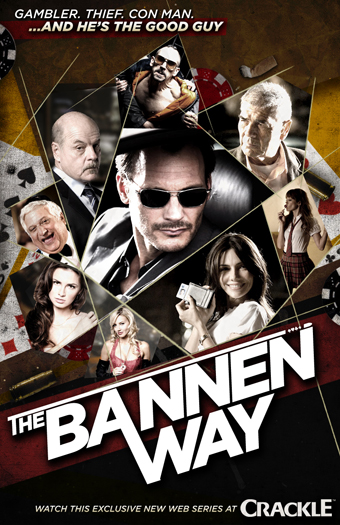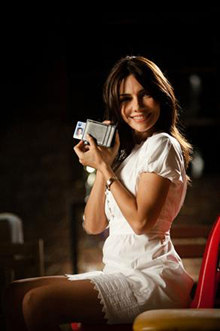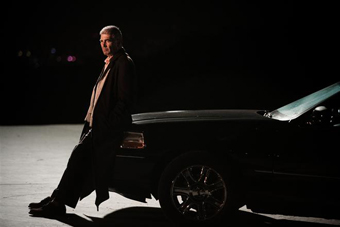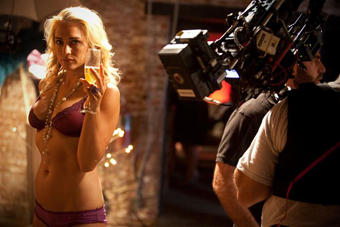Jesse Warren and Mark Gantt wanted creative control over their next project. So instead of pitching a TV series, they headed straight for the Web.

Mark Gantt, as Neal Bannen, with director Jesse Warren
That is where this story veers away from so many others almost like it. As the co-creators, co-writers and co-executive producers—and, respectively, director and star—of Crackle.com’s latest high-profile Web series,The Bannen Way, Warren and Gantt have learned how to navigate, by trial and error, a wider distribution market now opening up to filmmakers. Though the pair shot the series as a feature film, it was designed, from the start, to be cut into 14 distinct episodes that would grab its first audiences, virally, online.
Web First
Warren says he suggested to Gantt that they start, the usual way, by producing a short they could bring to Sundance. “But Gantt saw a real opportunity with this whole idea of a Web series,” says Warren. “I was pretty vague at what a Web series even was, but we did some research and it seemed like something that would be fun to do and would also give us access to cheap equipment.”
After identifying the largest audience for Web video—essentially 18 – 34-year-old men—the pair considered concepts that fit this demographic. “Jesse had written a script about this character Neal Bannen,” says Gantt. “We thought, ‘Hey, maybe we create something based on Bannen that’s a slick, sexy Web series that would attract that audience, and more important, attract the brands that also are going after that same audience.’” The brand brainstorming came very easily after that, says Gantt, with Maxim magazine and Jaguar at the top of the list. “We kept those brands in mind when writing the script: cars, women, technology, sunglasses—stuff that we like, buy, watch online,” he says.

The final marketing campaign for The Bannen Way on Crackle.com.
If done right, they thought, their project might have a second or even third act beyond the Web. “We were always thinking Web series first, but we wanted the option of selling it later as a DVD as a complete feature,” Gantt says. “It started off as twenty episodes that were five minutes long,” adds Warren. “That was our prototype, and Mark and I spent every day for a good six-to-eight months developing the first six episodes. We reworked it until it was perfect.” With each new draft, they sought feedback from industry friends. “A producer friend of ours told us to keep it moving and spice it up, which really spoke to me as a director,” says Warren. The basic story and pacing was set. Next, they got to work on their pitch.
Creating Bannen’s World
How do you create a viable pitch before you’ve shot a single minute of your film? “Luckily, Gantt’s also a talented graphic designer,” says Warren. “We made this mini Bible with everything in it, so we were really able to show potential audiences what the show would look like before we’d picked up a camera,” he says. To appeal more to the online networks it was courting, the pair also created a companion Web site, TheBannenWay.com, which contained photos and news about the stars of the series (it now links directly to Crackle.com’s Bannen Way site). “We set it up as, ‘Here’s the world that this Web site/series/online experience could be: You’ve got a synopsis of the series, news about the show and descriptions of all the characters,” says Warren.
The first actor they cast was Stana Katic, a friend of the pair from acting class. “She’d just done Quantum of Solace, so we put that bit of news up on our promo site,” says Gantt. “That gave me the courage to cold call Jaguar and say, ‘Hey, we’re doing this little Web series, and with Stana in the lead, it’s going to be pretty hot and sexy. Maybe we can get one of your cars.’ As a former prop guy, I knew all about product placement and knew how to deal with the marketing folks on these kinds of arrangements.”
Without any polished footage of their own, Warren and Gantt used a familiar placeholder to convey their project’s style to potential backers. “Jesse and I would say, ‘Remember those BMW Films, those five-minute action spots with Clive Owen? That’s what we want our series to look like,’” says Gantt. “So we were a bit shameless for our pitch—we took a clip from one of those films off of YouTube and put images from them on our site. There was a picture of me, as the main character, Neal Bannen, at the very top. But all the rest of the pictures were of Clive Owen. We never misrepresented it, though—we always pitched it as ‘Clive Owen and BMW Films-like.’”

Gantt and Warren’s pre-production pitch site, complete
with a Bond Girl and "borrowed" Clive Owen clips.
The site wasn’t all Owen all the time, however. Says Warren, “Mark and my wife (who plays a seductive assassin in the series) and I also went out to Melrose and shot a test. We shot it in four hours, edited it in four hours and included that on the site. We knew it wasn’t done with the right camera or lights, but we also knew we had to keep it honest. And surprisingly, people responded to the test really well, which was a huge relief. That’s when we knew we had a shot at this, because we knew with the right crew, we could do much, much better than that.”
Expanding their budget to match that lofty goal was another matter. “At the time, the going rate for an episode was about $5,000,” says Warren. “We knew this was going to take so much more.” They put together an investment prospectus, says Gantt, “with the budget, synopsis, our bios, character descriptions, and the full concept and pitch. We took that to meetings with a few people, including a few agents, but got the same response: ‘You guys aren’t really anybody. No offense, but you have to shoot something.’ This convinced us that we had to create our own thing first, because nobody is going to give us money without us showing them exactly what this will look like.” What they needed was a trailer.
Warren and Gantt set out to shoot two episodes from their shooting script, paying for everything themselves and pulling “a whole bunch of favors” from friends and colleagues impressed enough with their original pitch and Web site to donate their time for free. They were able to cobble together top talent to shoot, color correct, mix and edit segments of the first two episodes, which was captured with the RED ONE. “We edited a trailer out of those two segments, and that became our proof of concept,” says Warren. Gantt and Warren also got very lucky: that original production and post team, including the cinematographer, stuck with the project into its Crackle incarnation.
Bringing in the Babes
As the project evolved, Gantt continued to update the show’s pitch site, which included separate “Babes” pages aimed at a possible tie-in with Maxim, as well as a very stylized set of character pages, creating almost a “comic book sense of in-your-face characters that literally pop off your screen,” describes Warren. “We wanted to showcase the characters from the start,” he says. In doing so, they created even more layers and depth for a show that still, officially, had no green light.
At one point during this process, Warren and Gantt considered pitching the show as a pilot to the studios and networks. “Then we reminded ourselves, ‘Why did we start this?’” says Gantt. “First and foremost, I wanted an acting career and Jesse wanted a directing career. We knew that if we went to the networks now, it would just be too easy for them to push us aside, even though we were the creators.” The potential for doing something new, says Warren, convinced them to stay true to their original plan. “We were more excited about being trailblazers than in simply selling our idea to someone else,” he says. “We knew pitching it as a Web series would get more initial attention, and I’m really glad we decided to go that way, but it turned out to be right.”
Now with a solid pitch and trailer, the pair ramped up their networking efforts and sent out hundreds of e-mails to friends and colleagues. “One of the first to respond was a friend of mine who is an agent at ICM in the new media department,” says Gantt. “He was actually one of the guys from our first set of meetings, two years before, who said, politely, ‘You guys are nobody.’ But this time, our trailer proved that we didn’t need to have a seasoned director or top talent to do this project.” Through that contact came meetings with Disney, NBC, Fox and finally, Sony Pictures Television, which made them the best offer. “Each studio had some great viral ideas about how to get the show out there,” says Gantt, “but what seemed to work best with our original concept was Sony’s plan, which was to screen it first as a Web series but release it later as a feature on DVD and also as a television special on cable.”
Into Production
In March ’09, Warren and Gantt started working with Sony Pictures Television and “cranked out our script,” says Warren, a 134-page treatment that grew to 150 pages with the studio’s notes. “When we did the budget for that, of course, we knew we had to scale back, so we brought the shooting scripts back to 112 pages,” he says.
Because the project was the first Web series that was shot with a fully union crew—and Warren and Gantt had projected their initial budget wiith a non-union crew—the team immediately went into cost-saving mode. “We had to shoot everything in basically one location, Lacy Street Studios, with multiple sets,” says Warren. “Originally, we planned to shoot all over L.A. But we repurposed our sets three or four times, and with the help of our great production designer, George Beckett, and cinematographer, Roger Chingirian, they look different each time you see them.”

Gantt as Bannen in an episode from the series
Although Warren and Gantt sold their show to Sony with a largely unknown cast, once the shooting script began circulating, that soon changed. “We were told by the studio that we had to get some name talent in order to sell more DVDs,” says Gantt. “The only problem was, they also told us they didn’t have any extra money to do that.” The week the largely veteran cast fell into place was a turning point for the project, says Warren. “If we didn’t get the green light by that Friday, we were going to fold—we had to complete the project by the end of the year and there was talk that we weren’t going to make it.” Bond Girl Katic was no longer available, so television actress Vanessa Marcil, known for her recurring roles on Las Vegas and the soap opera General Hospital, stepped in, as did several other veteran character actors, including Robert Forster (Heroes), Michael Ironside (Top Gun, Total Recall, Starship Troopers) and Michael Lerner (A Serious Man, Elf, Barton Fink). “Suddenly we had this incredible, experienced ensemble cast that was working for very little money,” says Warren.” Ironside plays Chief Bannen, the police chief father to Gantt’s con-artist son. Forster plays the wayward uncle with mob connections. A vampy threesome, called the “Assassin Trio,” includes Warren’s wife, Autumn Reeser, and Gantt’s girlfriend, Brianne Davis. “They play ‘Jailbait and ‘Bombshell,’ ” Warren says. “We wanted to have fun with these characters and take them to a place of comic book, heightened reality that also played into that 18-34 male demographic. They have real names in the context of the show, of course, but one of our main characters gives them these names that basically define them.”

Lead actress Vanessa Marcil

Robert Forster, of Heroes, plays Neal Bannen’s uncle.

Warren’s wife Autumn Reeser as Jailbait
“Sony’s ad sales team, meanwhile, was “out there trying to bring in sponsorships,” says Gantt. “But we were on them about Maxim from the beginning.” The cross-promotional deal that was eventually reached mirrored Warren and Gantt’s original idea. For the first two weeks of January after the show launched, Maxim ran a “Bannen” player on its Web site that featured the show’s trailer and exclusive video of the “Bannen Babes” appearing in the series. On Sony’s Crackle site, a Maxim-branded “Bannen’s Black Book” features glossy shots and bios of Maxim‘s "Hometown Hotties" models as if compiled by Gantt’s character, Neal Bannen. Gantt called Jaguar again and ended up scoring the Jaguar XKR, a model not even in wide release, for the production. “I got hold of a woman, who deals with celebrity placement, who told me point blank that the ‘XKR is hot!’ I said, ‘That car isn’t even out yet.’ Turns out there was only one in the U.S. but it happened to be in LA. We had it for 19 days for the shoot, and luckily, I got to drive it around town for a few extra days after that.”

A Bannen Babe on set
Working with RED
The 19-day shoot was tight, to say the least. “We only had about ten-and-a-half hours a day to shoot, since we didn’t have the option of overtime,” says Warren. “We could have changed the script and gotten some overtime, but we had been rewriting and rewriting to the point where we felt like any more and we’ll start losing our story and back story,” says Gantt.
Fortunately, they say the RED workflow was seamless. “Our DP and editor had worked with the RED before,” says Gantt. “We also had an on-set DIT who put the footage on a drive as soon as it was shot and made a copy onto another drive. He dropped that drive off to the editor each night. People talk about how the RED workflow can be so difficult. But if you do it right, it’s an amazing camera with an amazingly easy workflow. We’re definitely going to use it again.”

The RED ONE overlooking LA
Though the show’s shooting schedule was tough, the post-production schedule was even more brutal. “We were working nonstop for 12 hours a day, every day,” says Warren. “I had two weeks for director’s cut and two weeks for studio notes. Sony also got to see a rough cut during production.” Warren and Gantt brought back the team that had helped them polish their pitch: editor Zack Arnold, from Fix It In Post; colorist Sebastian Perez-Burchard, from Tunnel Post; and sound designer and mixer Sam Aronson, from Sammy Sound. Sony, through its extensive connections in the music business, lined up ASCAP composer Joseph Trapanese for the soundtrack.
The Bannen Way premiered on December 29 (in order to qualify for the Streamy Awards) and officially debuted on Crackle.com and iTunes on Jan 6. The 16 episodes, shown serially and now all available for free on Crackle through February 19, have grabbed more than 8.4 million streams, making it Crackle.com’s fasting growing Web series to date. Crackle’s earlier high-profile effort, Angel of Death, took in half the number of viewers.
Was it also the most expensive Web series produced to date? “We had an all-union crew (IATSE, WGA, DGA and AFTRA), so a third of our budget went to payroll taxes and fringes. Not exactly what a couple indie producers are used to,” says Gantt. “Let’s just say that it cost much more than most Web series but much less than the usual television series or feature.” Not bad, especially when you consider that a cable network will air the complete series as a feature presentation sometime this spring. And thanks to Sony, anyone with a Sony Bravia TV can click on a built-in Crackle widget and watch the HD version of the Web series on their TV sets.
But even more gratifying than the numbers, says Gantt, is the instant feedback they received from fans on the site. “The comments have been overwhelmingly great. Everyone was blown away by the production values, story, acting, characters and directing,” he says. “We had worked so hard for so long—and the buzz had started to really build prior to launch—that it was a little surreal to have it suddenly be live and get so many positive e-mails from people who loved it and passed it on to all their friends.”
Some of those viewers suggested it would make great television as well, which didn’t surprise Warren and Gantt in the least. “We’ve always thought that this would make a great TV series, and we attempted to make the best-looking Web series we could make and make it feel as much like television or a feature. So when the fans told us, ‘This is better than most TV series out there. Why isn’t this on tv?’ we loved hearing that and are ready to develop it as a TV series.”
The entire sixteen episodes will be available for free on Crackle.com until February 19. The series, in full-length film form, will be available on-demand as a 24-hour rental for $3.99 and as a full purchase download for $14.99 at Amazon.com on February 22.

Sections: Creativity Technology
Topics: Feature Project/Case study
Did you enjoy this article? Sign up to receive the StudioDaily Fix eletter containing the latest stories, including news, videos, interviews, reviews and more.
Leave a Reply